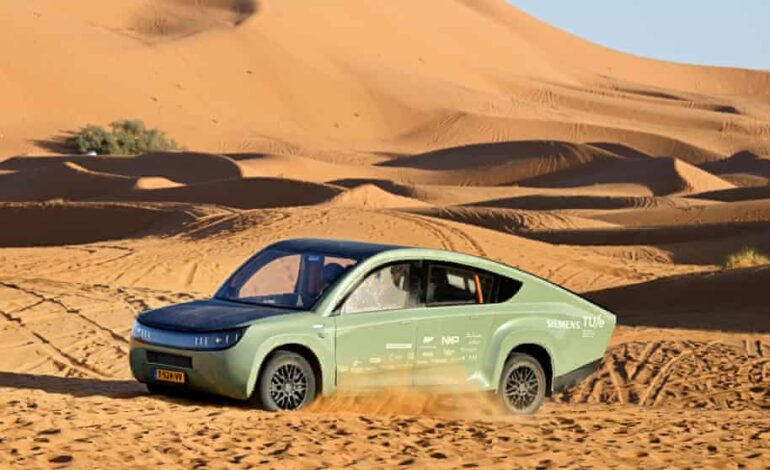
Faith Nyasuguta
A pioneering solar-powered car, known as Stella Terra, has achieved an incredible milestone, becoming the world’s first off-road, long-distance vehicle capable of traversing challenging terrains without recharging.
Crafted by a team of 22 students from Eindhoven University of Technology, this innovative two-seater completed a demanding 620-mile (1,000km) test drive through Morocco and the Sahara Desert.
Stella Terra is propelled by the energy harnessed from multiple solar panels embedded in its roof. This groundbreaking solar-powered vehicle, with a top speed of 90mph (145kmph), weighs a mere 1,200kg (1.2 tonnes) and boasts an impressive range of at least 440 miles (710km) on sunny days.
Wisse Bos, Solar Team Eindhoven’s manager, believes the technology integrated into Stella Terra, which combines a lightweight frame with highly efficient solar panels, stands a decade ahead of anything currently available in the market.
He noted, “Stella Terra must withstand the harsh conditions of off-roading while remaining efficient and light enough to be powered by the sun. That is why we had to design almost everything for Stella Terra ourselves, from the suspension to the inverters for the solar panels. We are pushing the boundaries of technology.”
This groundbreaking car is equipped with a rechargeable lithium-ion battery that enables it to function even in less sunny environments, albeit for shorter distances.
The solar panels generate an ample amount of electricity, not only for propulsion but also for practical use such as cooking and charging electronic devices like smartphones or cameras.
The team behind this innovation comprises young talents aged between 21 and 25, who embarked on this project after taking a year off from their studies.
During the test drive across the varied landscapes of North Africa, from Tangier to the Sahara, the car did face a challenge when the steering system failed. Still, the team quickly resolved the issue.
Bob van Ginkel, the project’s technical manager, explained, “We hope this can be an inspiration to car manufacturers such as Land Rover and BMW to make it a more sustainable industry.
“The car was actually very comfortable in the off-road conditions as it is very light and does not get stuck.”
One remarkable aspect of Stella Terra is its bespoke converter for the solar panels, which boasts a staggering 97% efficiency in converting absorbed sunlight into electrical charge. Furthermore, it was found that the vehicle exceeded its initial efficiency expectations by a third.
While there is still work to be done before the design can hit the market, it presents a promising avenue for major automobile manufacturers to explore.
The primary challenge faced by those developing solar-powered cars is the limited surface area for solar panels. To generate the energy required to power a vehicle over long distances, highly efficient panels are necessary, and these tend to be expensive.
The Stella Terra team operates as a not-for-profit organization and has relied on sponsorships for its budget, which makes it challenging to provide a total project cost.
This situation mirrors the challenges faced by other companies like Atlas Technologies, a subsidiary of the Netherlands-based Lightyear.
The company initially aimed to produce solar-electric cars, but their high retail cost led to bankruptcy due to a lack of orders.
Nevertheless, they have reemerged with a more cost-effective model that can travel around 500 miles between charges, marking a promising shift towards solar-powered vehicles in the automotive market.
RELATED:




